Adam Weisweiler, l'ébéniste de la cour et de toute l'aristocratie européenne
+2
Gouverneur Morris
La nuit, la neige
6 participants
LE FORUM DE MARIE-ANTOINETTE :: La France et le Monde au XVIIIe siècle :: Les Arts et l'artisanat au XVIIIe siècle :: Le mobilier du XVIIIe siècle
Page 2 sur 2
Page 2 sur 2 •  1, 2
1, 2
 Re: Adam Weisweiler, l'ébéniste de la cour et de toute l'aristocratie européenne
Re: Adam Weisweiler, l'ébéniste de la cour et de toute l'aristocratie européenne
Quel ravissant cabinet 
Merci Momo & LNLN

Merci Momo & LNLN

_________________
« elle dominait de la tête toutes les dames de sa cour, comme un grand chêne, dans une forêt, s'élève au-dessus des arbres qui l'environnent. »
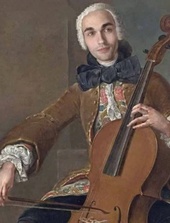
Comte d'Hézècques- Messages : 4390
Date d'inscription : 21/12/2013
Age : 44
Localisation : Pays-Bas autrichiens
 Re: Adam Weisweiler, l'ébéniste de la cour et de toute l'aristocratie européenne
Re: Adam Weisweiler, l'ébéniste de la cour et de toute l'aristocratie européenne
Quel travail merveilleux ! 
_________________
... demain est un autre jour .

Mme de Sabran- Messages : 55508
Date d'inscription : 21/12/2013
Localisation : l'Ouest sauvage
 Re: Adam Weisweiler, l'ébéniste de la cour et de toute l'aristocratie européenne
Re: Adam Weisweiler, l'ébéniste de la cour et de toute l'aristocratie européenne
Quelle raffinement !! 
Sera prochainement proposé en vente aux enchères ce...
LATE LOUIS XVI ORMOLU-MOUNTED THUYA, EBONY AND JAPANESE LACQUER SECRETAIRE A ABATTANT
BY ADAM WEISWEILER, AND ALMOST CERTAINLY SUPPLIED BY DOMINIQUE DAGUERRE
THE ORMOLU POSSIBLY BY FRANÇOIS REMOND
CIRCA 1790-1795
The rouge griotte marble top over palmette and anthemion frieze atop black and gold lacquered front and side panels flanked by turned and tapered columnar supports, central fall-front mounted with an ormolu roundel depicting Minerva teaching a mother and her children, the fall-front opening to an interior fitted with four drawers, the lower long drawer mounted with an ormolu plaque depicting agricultural pursuits and resting on faceted tapered legs connected by a stretcher on toupie feet; the top with painted inventory number 'R162', with additional label indistinctly inscribed '...Cire Meuble-5-1199', the back with paper label inscribed in ink 'E de R No 14' and 'No 182 / CN53 / 1..2..75 X 40' in white chalk, the underside of marble with Rothschild label inscribed in ink 'No 2' and with Chenue transit label 'P. Cervonnier', '3325' in pencil, 'SABET 10075' and '#10 D6714 1 OF 2' on packing tape; the ormolu plaque of the fall-front probably original, but of slightly different chasing and gilding, indicating a possible change of heart in the commission
49 ¾ in. (126.4 cm.) high, 27 ½ in. (70 cm.) wide, 13 ½ in. (34.3 cm.) deep

Lot Essay
Adam Weisweiler, maître in 1778.
This magnificent, jewel-like secretaire, with its sumptuous use of seventeenth-century Japanese lacquer and beautifully chased mounts, is a masterpiece of French cabinetry and is the perfect synthesis between Adam Weisweiler, a supremely talented ébéniste at the height of his powers, and one of the era’s most creative and influential marchands-merciers, Dominique Daguerre.
THE DESIGN
The form and ornament of this secretaire is one of the most sophisticated interpretations of the many elements seen in Weisweiler’s commissions for Daguerre towards the end of the ancien régime. Daguerre had an enormous stock of luxurious materials including 17th century Japanese lacquer, Florentine hardstone panels and rare porcelains. His designs, which would break up and combine these materials in a seemingly endless variety of ways, created a luxurious and instantly desirable new aesthetic.

However, it was Daguerre’s extensive network of highly skilled bronziers and ébénistes that turned his designs into a finished product. The beautifully interlaced stretcher is typical of Weisweiler's oeuvre, while the complex series of turned elements of the uprights flanking the fall-front recur with variations (some partly in ebony, some incorporating caryatids) on several secretaires signed by him, for instance an example with pietra dura plaques sold in these rooms from the collection of Dalva Brothers, 22 October 2020, lot 65 ($1,134,000).

Louis XVI Pietra Dura and Ormolu-Mounted Ebony Secrétaire en Cabinet
Adam Weisweiler
c. 1785-90
Image : Christie's - Sale Dalva Brothers
THE MOUNTS
This secretaire achieves the perfect balance between sobriety and luxury. The deceptively simple form is offset by the judicious use of luxurious Japanese lacquer panels and restrained, beautifully chased ormolu mounts, almost certainly by the bronzier François Rémond.
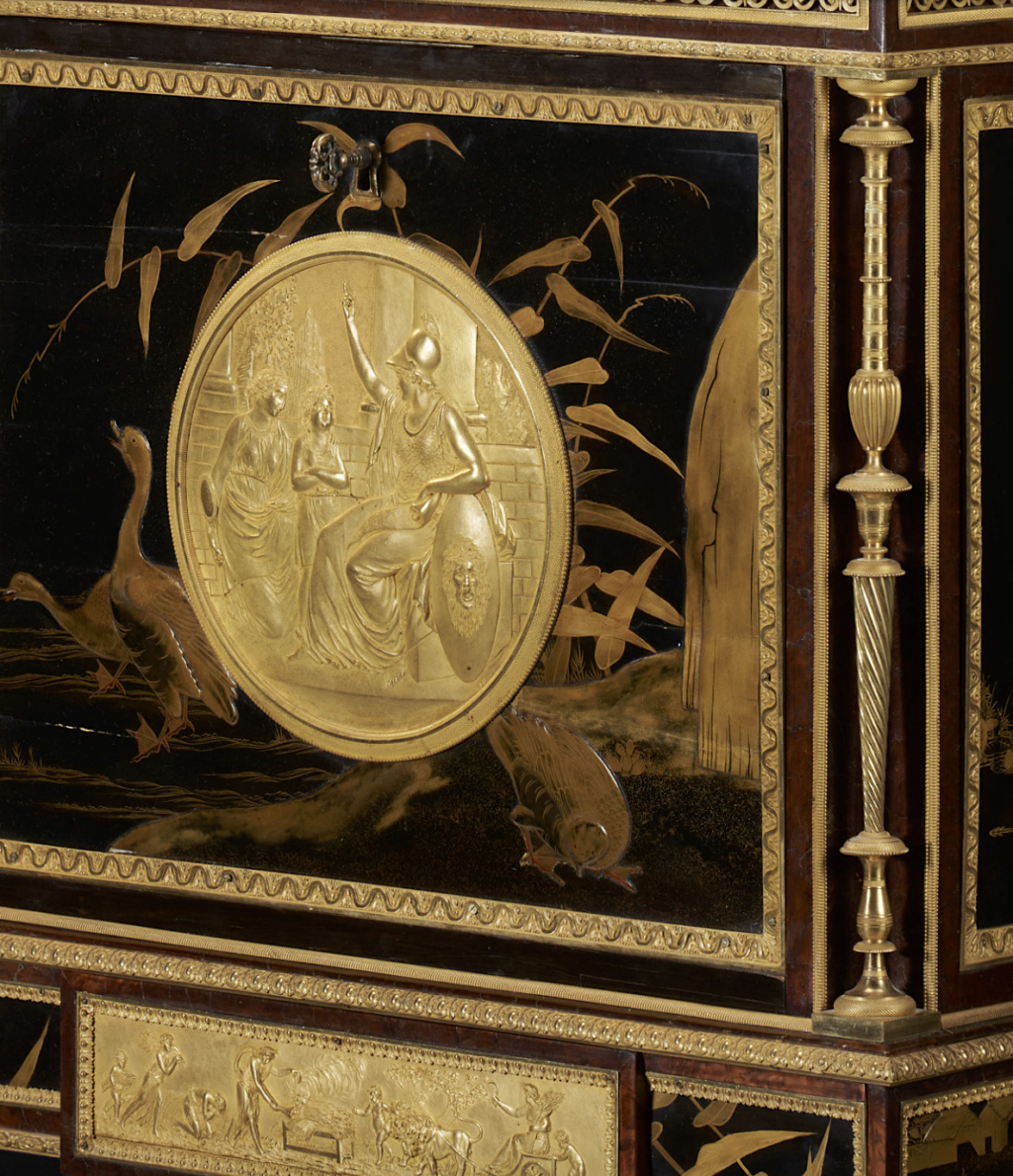
Although he worked independently with some of the leading Parisian ébénistes, Rémond had an extensive relationship with Daguerre and was his principal supplier; he is recorded to have supplied work valued at the staggering sum of 920,000 livres between 1778 and 1792. The distinctive palmettes of the frieze, rarely seen in pieces by Weisweiler, are typical of Rémond's oeuvre, while the striking ribboned mount framing the fall-front and side panels, in combination with the fluted moulding of the base features on other secretaires by Weisweiler, for instance on a spectacular example with Sèvres and Wedgwood plaques, recorded in a Revolutionary inventory at Versailles and now in the Kress Collection of the Metropolitan Museum, New York (illustrated Lemonnier op. cit., p. 65).
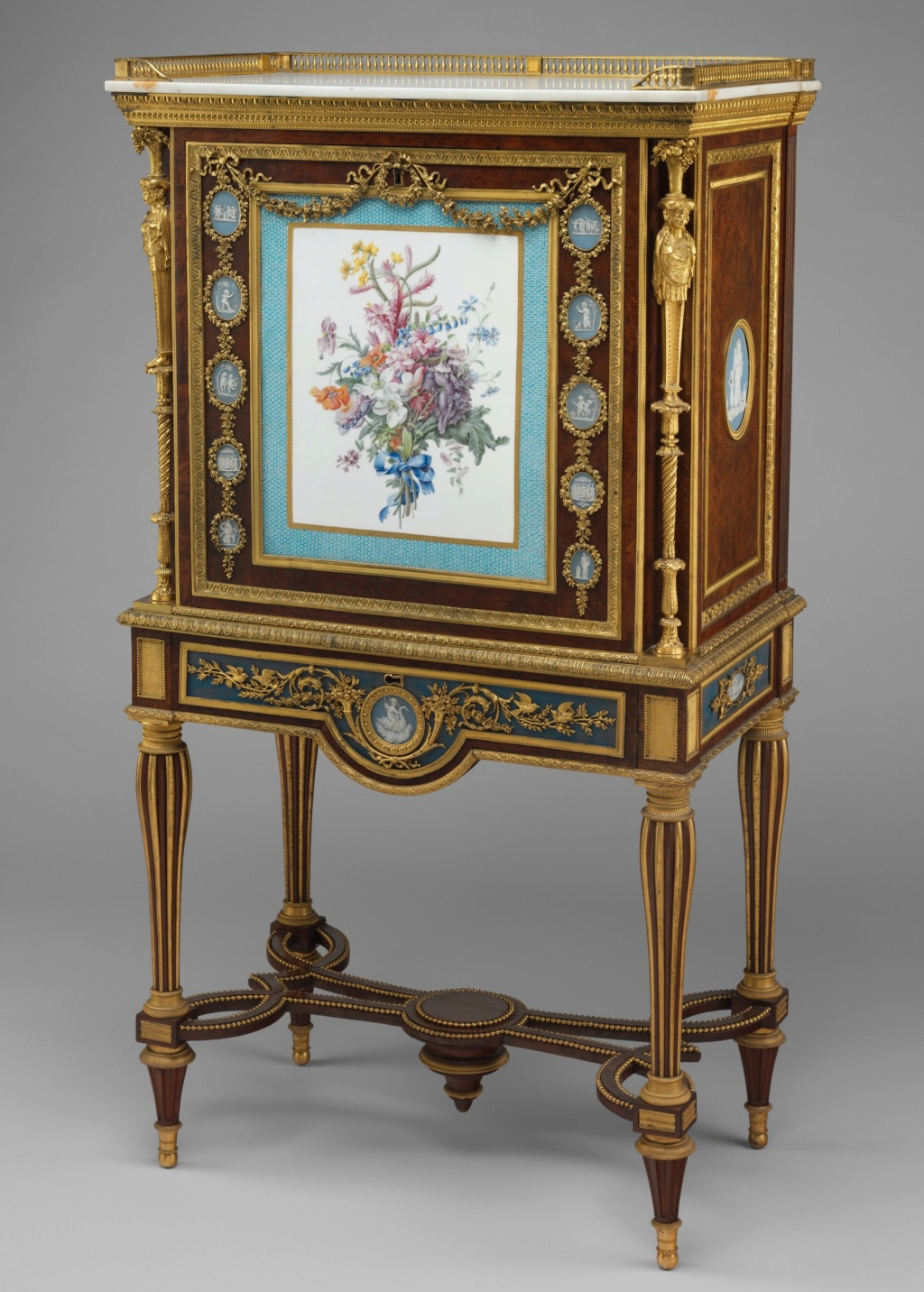
Secrétaire en cabinet
Attributed to Adam Weisweiler
May have been the last piece that Dominique Daguerre delivered to Marie-Antoinette at the château de Versailles
Image : The Metropolitan Museum
THE MEDALLION
When published by Patrice Lemonnier in her groundbreaking monograph on Weisweiler, it was suggested that the spectacular relief-cast medallion in the fall-front, depicting Minerva educating children, was possibly a later addition. However, a close examination of the bronzes of this secretaire has shown that the chasing is extremely close to the fine chasing of the frieze medallion, leading to the conclusion that it is contemporary to the other mounts, albeit with slightly different gilding suggesting it may have been a change of heart within the workshop, perhaps as a result of a specific request from a client.

This conclusion is substantiated by the fact that it is recorded as early as 1822 with its plaque in a sale of the stock of the dealer Daval, where it is described as:
"n°271. Un petit secrétaire à abattant, orné de panneaux en laque et décorés de moulures et autres ornements en bronze doré. Le panneau du milieu offre un riche médaillon de bronze doré, sujet de Marie-Antoinette sous la figure de Minerve, et présidant à l'éducation de ses enfants. L'intérieur d'un travail très soigné, est garni en bois de citron".
It is fascinating to note that the cataloguer thought that Minerva was actually Marie-Antoinette in the guise of the goddess, such was the passion for the ancien régime following the restoration of the monarchy in France.

WEISWEILER AND DAGUERRE
Born in Neuwied, Weisweiler is believed to have studied with David Roentgen (1743-1807) before emigrating to Paris, where he was established as an artisan libre – a foreign worker protected by the medieval right of refuge – by 1777, the year of his marriage. The following year he became a maître-ébéniste, and established his workshop on the rue du Faubourg Saint-Antoine, joining Reisener and the elite group of German artisans providing pieces for the French royal family.
While he is recorded to have worked with the marchand-mercier Julliot, the luxury pieces for which he is best known were almost exclusively sold directly through Dominique Daguerre. He provided the designs for many of Weisweiler’s most important commissions and together they supplied the most influential and esteemed patrons of their day: Louis XVI and Marie Antoinette, George, Prince of Wales (later King George IV), and Grand Duchess Maria Feodorovna and Grand Duke Paul of Russia.

The heir to Simon-Philippe Poirier's atelier, Daguerre was the foremost Parisian marchand-mercier of the last decades of the Ancien Régime. From the 1770s onward, he was the prevailing tastemaker in Paris and subsequently London where he opened a second atelier in 1778 to meet the demands of his growing clientele. He specialized in supplying objets de luxe to the French court and, increasingly during the 1780s, to the English and foreign nobility. He supplied the furniture to George, Prince of Wales for Carlton House as well as Brighton Pavilion.
In 1787 alone, Daguerre’s bill to the Prince of Wales was a staggering £14,565 13s 6d. Daguerre also worked for the Prince’s circle and provided furniture to Duke of Bedford for Woburn Abbey and Earl Spencer for Althorp. By 1791, financial constraints and current events necessitated the sale of his stock at Christie’s which was enough to fill an entire catalogue.

BARON ALPHONSE DE ROTHSCHILD
The secretaire was recorded in 1905 in the fabled collection of Baron Alphonse de Rothschild in the Hôtel de Saint-Florentin. The principal Parisian residence of the second generation of French Rothschilds, the Hôtel de Saint-Florentin (also known as the Hôtel de Talleyrand), was refurbished and expanded by Alphonse de Rothschild (1827-1905), the eldest son and heir of James de Rothschild.
Adjacent to the Hôtel de la Marine and facing the Place de la Concorde, the building designed by Jean-François Chalgrin in 1769 was bought by James de Rothschild in 1838 but first occupied by Alphonse and his wife (and English cousin) Leonora in 1867 as James and Betty continued to live at their house at 19 rue Laffitte. Alphonse and Leonora filled the house with their superb collections of paintings, maiolica, enamels, furniture, sculpture and works of art.
Whereas the collection of the celebrated château de Ferrieres was mainly conceived by James as an expression of his family’s European essence, the hôtel Saint-Florentin projected Alphonse’s particular taste for French eighteenth-century decorative arts, including boiseries from Madame du Barry’s château de Louveciennes and sculptures from the château de Ménars of Madame de Pompadour. Influenced by the taste of the Ancien Régime in line with his political views, the hôtel contained an important collection of Sèvres porcelain, exquisite eighteenth-century furniture and the choicest paintings by the great French masters of the eighteenth century such as Watteau, Fragonard and Greuze.
* Source et infos complémentaires : Christie's New York - Vente du 1er février 2024

Sera prochainement proposé en vente aux enchères ce...
LATE LOUIS XVI ORMOLU-MOUNTED THUYA, EBONY AND JAPANESE LACQUER SECRETAIRE A ABATTANT
BY ADAM WEISWEILER, AND ALMOST CERTAINLY SUPPLIED BY DOMINIQUE DAGUERRE
THE ORMOLU POSSIBLY BY FRANÇOIS REMOND
CIRCA 1790-1795
The rouge griotte marble top over palmette and anthemion frieze atop black and gold lacquered front and side panels flanked by turned and tapered columnar supports, central fall-front mounted with an ormolu roundel depicting Minerva teaching a mother and her children, the fall-front opening to an interior fitted with four drawers, the lower long drawer mounted with an ormolu plaque depicting agricultural pursuits and resting on faceted tapered legs connected by a stretcher on toupie feet; the top with painted inventory number 'R162', with additional label indistinctly inscribed '...Cire Meuble-5-1199', the back with paper label inscribed in ink 'E de R No 14' and 'No 182 / CN53 / 1..2..75 X 40' in white chalk, the underside of marble with Rothschild label inscribed in ink 'No 2' and with Chenue transit label 'P. Cervonnier', '3325' in pencil, 'SABET 10075' and '#10 D6714 1 OF 2' on packing tape; the ormolu plaque of the fall-front probably original, but of slightly different chasing and gilding, indicating a possible change of heart in the commission
49 ¾ in. (126.4 cm.) high, 27 ½ in. (70 cm.) wide, 13 ½ in. (34.3 cm.) deep

Lot Essay
Adam Weisweiler, maître in 1778.
This magnificent, jewel-like secretaire, with its sumptuous use of seventeenth-century Japanese lacquer and beautifully chased mounts, is a masterpiece of French cabinetry and is the perfect synthesis between Adam Weisweiler, a supremely talented ébéniste at the height of his powers, and one of the era’s most creative and influential marchands-merciers, Dominique Daguerre.
THE DESIGN
The form and ornament of this secretaire is one of the most sophisticated interpretations of the many elements seen in Weisweiler’s commissions for Daguerre towards the end of the ancien régime. Daguerre had an enormous stock of luxurious materials including 17th century Japanese lacquer, Florentine hardstone panels and rare porcelains. His designs, which would break up and combine these materials in a seemingly endless variety of ways, created a luxurious and instantly desirable new aesthetic.

However, it was Daguerre’s extensive network of highly skilled bronziers and ébénistes that turned his designs into a finished product. The beautifully interlaced stretcher is typical of Weisweiler's oeuvre, while the complex series of turned elements of the uprights flanking the fall-front recur with variations (some partly in ebony, some incorporating caryatids) on several secretaires signed by him, for instance an example with pietra dura plaques sold in these rooms from the collection of Dalva Brothers, 22 October 2020, lot 65 ($1,134,000).

Louis XVI Pietra Dura and Ormolu-Mounted Ebony Secrétaire en Cabinet
Adam Weisweiler
c. 1785-90
Image : Christie's - Sale Dalva Brothers
THE MOUNTS
This secretaire achieves the perfect balance between sobriety and luxury. The deceptively simple form is offset by the judicious use of luxurious Japanese lacquer panels and restrained, beautifully chased ormolu mounts, almost certainly by the bronzier François Rémond.

Although he worked independently with some of the leading Parisian ébénistes, Rémond had an extensive relationship with Daguerre and was his principal supplier; he is recorded to have supplied work valued at the staggering sum of 920,000 livres between 1778 and 1792. The distinctive palmettes of the frieze, rarely seen in pieces by Weisweiler, are typical of Rémond's oeuvre, while the striking ribboned mount framing the fall-front and side panels, in combination with the fluted moulding of the base features on other secretaires by Weisweiler, for instance on a spectacular example with Sèvres and Wedgwood plaques, recorded in a Revolutionary inventory at Versailles and now in the Kress Collection of the Metropolitan Museum, New York (illustrated Lemonnier op. cit., p. 65).

Secrétaire en cabinet
Attributed to Adam Weisweiler
May have been the last piece that Dominique Daguerre delivered to Marie-Antoinette at the château de Versailles
Image : The Metropolitan Museum
THE MEDALLION
When published by Patrice Lemonnier in her groundbreaking monograph on Weisweiler, it was suggested that the spectacular relief-cast medallion in the fall-front, depicting Minerva educating children, was possibly a later addition. However, a close examination of the bronzes of this secretaire has shown that the chasing is extremely close to the fine chasing of the frieze medallion, leading to the conclusion that it is contemporary to the other mounts, albeit with slightly different gilding suggesting it may have been a change of heart within the workshop, perhaps as a result of a specific request from a client.

This conclusion is substantiated by the fact that it is recorded as early as 1822 with its plaque in a sale of the stock of the dealer Daval, where it is described as:
"n°271. Un petit secrétaire à abattant, orné de panneaux en laque et décorés de moulures et autres ornements en bronze doré. Le panneau du milieu offre un riche médaillon de bronze doré, sujet de Marie-Antoinette sous la figure de Minerve, et présidant à l'éducation de ses enfants. L'intérieur d'un travail très soigné, est garni en bois de citron".
It is fascinating to note that the cataloguer thought that Minerva was actually Marie-Antoinette in the guise of the goddess, such was the passion for the ancien régime following the restoration of the monarchy in France.

WEISWEILER AND DAGUERRE
Born in Neuwied, Weisweiler is believed to have studied with David Roentgen (1743-1807) before emigrating to Paris, where he was established as an artisan libre – a foreign worker protected by the medieval right of refuge – by 1777, the year of his marriage. The following year he became a maître-ébéniste, and established his workshop on the rue du Faubourg Saint-Antoine, joining Reisener and the elite group of German artisans providing pieces for the French royal family.
While he is recorded to have worked with the marchand-mercier Julliot, the luxury pieces for which he is best known were almost exclusively sold directly through Dominique Daguerre. He provided the designs for many of Weisweiler’s most important commissions and together they supplied the most influential and esteemed patrons of their day: Louis XVI and Marie Antoinette, George, Prince of Wales (later King George IV), and Grand Duchess Maria Feodorovna and Grand Duke Paul of Russia.

The heir to Simon-Philippe Poirier's atelier, Daguerre was the foremost Parisian marchand-mercier of the last decades of the Ancien Régime. From the 1770s onward, he was the prevailing tastemaker in Paris and subsequently London where he opened a second atelier in 1778 to meet the demands of his growing clientele. He specialized in supplying objets de luxe to the French court and, increasingly during the 1780s, to the English and foreign nobility. He supplied the furniture to George, Prince of Wales for Carlton House as well as Brighton Pavilion.
In 1787 alone, Daguerre’s bill to the Prince of Wales was a staggering £14,565 13s 6d. Daguerre also worked for the Prince’s circle and provided furniture to Duke of Bedford for Woburn Abbey and Earl Spencer for Althorp. By 1791, financial constraints and current events necessitated the sale of his stock at Christie’s which was enough to fill an entire catalogue.

BARON ALPHONSE DE ROTHSCHILD
The secretaire was recorded in 1905 in the fabled collection of Baron Alphonse de Rothschild in the Hôtel de Saint-Florentin. The principal Parisian residence of the second generation of French Rothschilds, the Hôtel de Saint-Florentin (also known as the Hôtel de Talleyrand), was refurbished and expanded by Alphonse de Rothschild (1827-1905), the eldest son and heir of James de Rothschild.
Adjacent to the Hôtel de la Marine and facing the Place de la Concorde, the building designed by Jean-François Chalgrin in 1769 was bought by James de Rothschild in 1838 but first occupied by Alphonse and his wife (and English cousin) Leonora in 1867 as James and Betty continued to live at their house at 19 rue Laffitte. Alphonse and Leonora filled the house with their superb collections of paintings, maiolica, enamels, furniture, sculpture and works of art.
Whereas the collection of the celebrated château de Ferrieres was mainly conceived by James as an expression of his family’s European essence, the hôtel Saint-Florentin projected Alphonse’s particular taste for French eighteenth-century decorative arts, including boiseries from Madame du Barry’s château de Louveciennes and sculptures from the château de Ménars of Madame de Pompadour. Influenced by the taste of the Ancien Régime in line with his political views, the hôtel contained an important collection of Sèvres porcelain, exquisite eighteenth-century furniture and the choicest paintings by the great French masters of the eighteenth century such as Watteau, Fragonard and Greuze.
* Source et infos complémentaires : Christie's New York - Vente du 1er février 2024
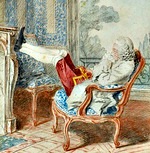
La nuit, la neige- Messages : 18137
Date d'inscription : 21/12/2013
 Re: Adam Weisweiler, l'ébéniste de la cour et de toute l'aristocratie européenne
Re: Adam Weisweiler, l'ébéniste de la cour et de toute l'aristocratie européenne
C'est vraiment le nec plus ultra du raffinement !
L'allégorie de la Vérité pose sa main sur l'épaule du jeune élève d'Athéna.
Merci à toi de nous faire rêver ...
L'allégorie de la Vérité pose sa main sur l'épaule du jeune élève d'Athéna.
Merci à toi de nous faire rêver ...

_________________
... demain est un autre jour .

Mme de Sabran- Messages : 55508
Date d'inscription : 21/12/2013
Localisation : l'Ouest sauvage
 Re: Adam Weisweiler, l'ébéniste de la cour et de toute l'aristocratie européenne
Re: Adam Weisweiler, l'ébéniste de la cour et de toute l'aristocratie européenne
Je suis comme toi Eleo je trouve ce meuble sublime
Mélange de laques de Chine de bronze, de style j’adore
Mélange de laques de Chine de bronze, de style j’adore
_________________
Un verre d'eau pour la Reine.
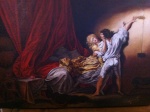
Mr de Talaru- Messages : 3193
Date d'inscription : 02/01/2014
Age : 65
Localisation : près des Cordeliers...
Page 2 sur 2 •  1, 2
1, 2
 Sujets similaires
Sujets similaires» Le mobilier néo-classique et le renouveau du « style Boulle » dans les années 1770-1780 : Etienne Levasseur et Adam Weisweiler
» Mobilier du XVIIIe siècle à décors de panneaux de mosaïques de pierres dures (pietra dura), par Adam Weisweiler et Martin Carlin
» La canicule européenne de 1757
» Un secrétaire Weisweiler de Marie-Antoinette à Vienne ?
» Turquerie, une fantaisie européenne du XVIIIe siècle, de Haydn Williams
» Mobilier du XVIIIe siècle à décors de panneaux de mosaïques de pierres dures (pietra dura), par Adam Weisweiler et Martin Carlin
» La canicule européenne de 1757
» Un secrétaire Weisweiler de Marie-Antoinette à Vienne ?
» Turquerie, une fantaisie européenne du XVIIIe siècle, de Haydn Williams
LE FORUM DE MARIE-ANTOINETTE :: La France et le Monde au XVIIIe siècle :: Les Arts et l'artisanat au XVIIIe siècle :: Le mobilier du XVIIIe siècle
Page 2 sur 2
Permission de ce forum:
Vous ne pouvez pas répondre aux sujets dans ce forum